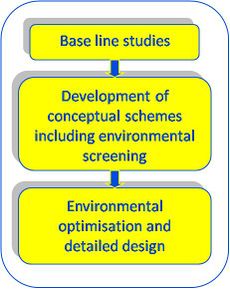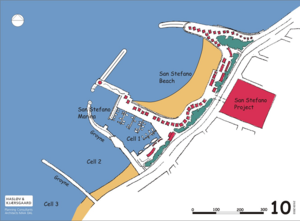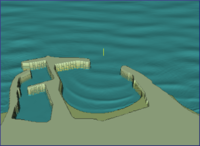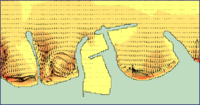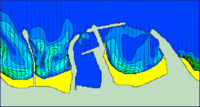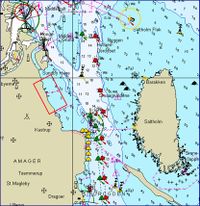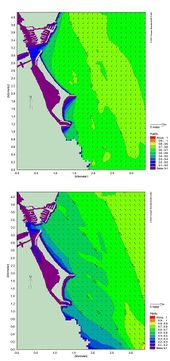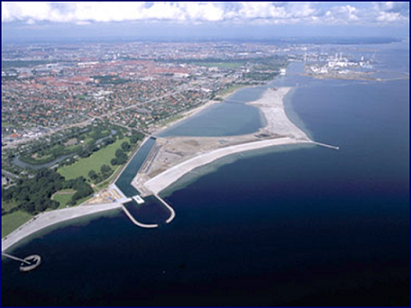How to apply models
Numerical models have reached a level of accuracy and detail over the past 25 years that most of the dominant processes in the coastal environment can be quantified. However, the numerical models are tools only for the coastal engineers and planners. This article on How to apply models will discuss the optimal use of the modelling tools at various stages of a coastal development project. Further, examples are given of projects where proper analysis and modelling have formed the basis for successful coastal projects.
Contents
Introduction
The description in this article will concentrate on development of high quality and safe artificial beaches, as these are often one of the most important assets of coastal development schemes. It is recommended that the planning of a coastal development scheme includes the following coastal engineering disciplines:
- Baseline studies of ocean and coastal conditions leading to:
- Baseline description of wind, waves and tides in the area
- Coastal classification (see Characteristics of sedimentary shores, Classification of coastal profiles and Morphology of estuaries)
- Description of littoral drift conditions (see Littoral drift and shoreline modelling and Coastal Hydrodynamics And Transport Processes)
- Equilibrium profile and orientation of shorelines (see Shoreface profile and Stability models)
- Description of variability in above conditions
- Development of alternative schemes shall be done in close collaboration between the developer, coastal engineers, architects, planners and authorities taking into consideration the specific constraints and possibilities at the site and the impact on adjacent beaches or areas, and the general rules regulations and master plans for the area. During this process it is important to combine the goals of the developer with the possibilities provided at the specific site and to refrain from trying to develop facilities which will not function at the site. Development of conceptual schemes with artificial beaches and lagoons shall be done so respecting the natural conditions in the area and including environmental screening. Selection of preferred conceptual scheme(s) occurs as the number of alternative schemes is reduced through a process, which weighs pros and cons for all aspects of a project.
- Detailed design and environmental optimization of the scheme using advanced numerical models.
Baseline Studies
Overview of parameters
The parameters of importance for development of good quality beaches and lagoons are the following:
- Astronomical tide, which is responsible for the periodic water level variations and the associated tidal flushing in the area
- The varying air pressure and wind systems, which are responsible for the generation of storm surges and wind waves
- Wave generation and wave propagation from deep water to shallow water
- Littoral drift and shoreline stability, which are mainly dependent of wave conditions and the seabed characteristics
Illustrations of the important wave and littoral transport processes, which can be simulated by the numerical models, are presented in Fig. 1.
Regional modelling
Sufficiently long recording of time series of tides and waves is normally not available at a project site as basis for establishment of design conditions, whereas wind recordings and weather maps are normally available from local meteorological stations and international organisations. Such wind and air pressure data are very suitable as input data for spectral wind wave models and 2D or 3D hydrodynamic flow models. The combination of advanced numerical wave and hydrodynamic models and powerful computers thus makes it possible to run long time series, i.e. decades of years, of hydrodynamic and wind wave simulations thereby providing basis for establishment of a baseline description of the following offshore conditions:
- Winds
- Waves
- Currents and flushing conditions
- Tides and storm surges
Possible shorter recording time series of waves, tides and currents are suitable for calibration of the numerical models. The established time series of regional marine parameters are thereafter suitable for statistical description of normal conditions as well as of design conditions. Furthermore, the established regional models can provide boundary conditions for local wave, hydrodynamic and sediment transport models as required as well as boundary conditions for littoral drift and shoreline evolution models. An example is the PERGOS model covering the entire Gulf as well as the Oman Gulf and part of the Arabian Sea. The model has been run continuously for 20 years and in addition for 100 storms. The outputs of the model are, among others, the following:
- Extremes of wind speed, wave height/period, water level and currents
- Time series of wind, waves, water levels and currents are provided for 100-storm events and the continuous 20-year period 1983-2002.
Example of output from the model is presented in Fig. 2.
Local area modelling
The study of the conditions in the local project area will normally require the establishment of local models. The new generation of such models are Flexible Mesh Models, in which the local model resolution can be adjusted as required. This technique provides the possibility of modelling large areas in one single model without shifting to several layers of finer grid models. An example of such a model grid covering the Dubai coast is presented in Fig. 3. An example of the wave conditions in the area using the above model grid is presented in Fig. 4.
Littoral drift modelling (see Littoral drift and shoreline modelling )
Modelling of the littoral drift conditions, i.e. the wave generated transport of sand in the surf zone, is required for studying the following conditions in the project area:
- Understanding of the stability conditions of the coast in the project area
- Defining the equilibrium orientation for new shorelines in the project area, which is required for the planning of new artificial beaches
- Establishing the impact of new structures in adjacent areas
- Establishing statistical correlation between wave conditions and littoral transport conditions, which is important for selecting representative situations for 2D modelling.
Scheme Conception
Requirements of a scheme
The concept for a coastal development scheme in a certain area is driven by the demand for a certain type of development. The development will typically consist of different types of basic elements, such as reclamation of new land, establishment of new water bodies by excavation of lagoons and establishment of new artificial beaches. The following concentrates on the development of artificial beaches. The requirements of a good quality artificial beach are normally the following:
- The beaches shall be moderately exposed to waves as it is the constant exposure of the waves which provides the fresh and attractive beach. Too much wave exposure makes the beaches unsafe for bathing
- They shall be orientated towards the direction of the prevailing waves to be stable. The lateral stability shall also be secured by terminal structures
- Artificial beaches shall be constructed of good quality beach sand: medium, i.e. 0.25 mm < d50 < 0.5 mm, well sorted, attractive colour, minimum content of fines and minimum content of coarse fractions and no content of organic matter
- Coastal structures adjacent to beaches shall be designed so that no dangerous currents are generated
These requirements shall be compared to the prevailing conditions at the site and the artificial beaches shall be developed accordingly.
Characteristics of the site
The characteristics of the site may or may not fit to the requirements for establishment of good quality and safe beaches as described above. In principle there are two main types of deviations relative to the requirements:
- The site is too exposed to provide safe bathing
- The site is too sheltered to provide a good quality beach
In the first case the scheme must provide partial protection of new artificial beaches to fulfil the requirements for bathing safety. In the second case the reason for the too sheltered conditions shall be clarified. If the reason is the presence of a shallow reef or similar, the required wave exposure can be established by cutting away the reef or by moving the beach to the seaward side of the reef.
Optimisation of the Scheme by Numerical Modelling
The use of numerical modelling following the scheme conception, where the coastal conditions at the site have been taken into consideration in respect of location, protection and orientation of local beaches, are demonstrated in the following via some examples.
| 4.1 Example 1. San Stefano project
The San Stefano site is located on the exposed Mediterranean water front of Alexandria, Egypt. The wave conditions at the site are rough and there is no natural beach at the site, which means that an artificial partly sheltered beach should be developed. The concept for the new beach was therefore a pocket beach inside an artificial bay formed by some major breakwater structures. The functions of the structures were the following:
The concept for the beach fulfilling these conditions is presented in Fig. 5. above. The concept was tested by application of the following types of numerical models. Optimisation of the layout of the structures through first estimate of the bay shape by detailed modelling of the diffraction pattern (Fig. 6). Fine tuning of the shape of the bay was made by modelling the sediment transport pattern by the sediment model MIKE 21 ST, which was driven by a parabolic mild slope wave model, MIKE 21 PMS, and a depth integrated hydrodynamic model, MIKE 21 HD. See Fig. 7. for a typical sediment transport pattern. The modelling results show that no sediments are escaping the bay and that only local transport is seen along the beach, which means that only local adjustments will take place dependent of the varying offshore wave conditions. Finally, the wave generated currents in the bay were checked. The concept here was that no strong currents must reach the deep water at the entrance to the bay, as this could be dangerous for poor swimmers. The important parameter here is to make the bay sufficiently large so that currents do not reach the entrance area. See typical current pattern in Fig. 8. |
| 4.2 Example 2. Amager Beach Park
Amager beach is located out to the Sound in Copenhagen, Denmark. The problem at this site is that the existing beach is of a poor quality (muddy shore-face) due to lack of wave exposure. The site is only moderately exposed and the existing beach is further protected due to a very shallow shoreface, see Fig. 9. A new beach park was recently built at this location using the principle of making the new beaches exposed by moving them out to deep water. Thereby the shelter provided by the shallow shoreface is avoided. The main concept for the new beach park has been to move the beaches seaward beyond the shallow shoreface thereby providing most possible wave exposure, which, however, is still moderate. The new beaches have been constructed on an island and a new lagoon (deepened) has been excavated between the island and the old shoreline. As the beach park is located near the gorge section of the Sound between Denmark and Sweden, there is always a good gradient on the water surface in the area of the beach park. This situation has been utilised to generate a good flushing in the lagoon by making two openings, one in the northern and one in the southern end. The flushing of the lagoon has been investigated by numerical modelling utilising the advection-dispersion module of the MIKE 21 software. The wave climate at the site is characterised by having two main directions, namely NE and SE, which is due to the shelter provided by the island located just opposite the site. This situation has been utilised to create two sections of beaches separated by a headland, one facing towards NE and one facing towards SE. The headland provides shelter at the NE facing beach for waves from SE and shelter at the SE facing beach for waves from NE, respectively (Fig. 10). The exact equilibrium shapes of the two beaches have been established by extracting wave climates from the wave modelling at a series of points along the beaches. Thereafter the equilibrium orientations were established at these points by the use of the littoral transport model LITPACK. Finally, the shapes of the beaches were fitted to the series of equilibrium orientations. An aerial photo of the new beach park just after finalisation of the civil works is presented in Fig. 11.
|
Conclusions
This article describes the optimal use of advanced hydraulic modelling tools for the design of coastal development schemes. However, it is also demonstrated that the modelling exercises will only be successful if the scheme concepts have been developed through understanding and utilisation of the site specific hydraulic and coastal mechanisms, which are characteristic for the project site. The optimal use of numerical models can therefore briefly be characterised as follows:
- Perform basic hydraulic and coastal studies utilizing existing data and regional numerical models
- Develop concepts for development schemes by utilizing the basic information on coastal processes and the concept of “work with nature”
- Utilize detailed numerical models to optimize the hydraulic and coastal performance of the schemes including optimization through minimization of negative impacts.
Related articles
- Modelling coastal hydrodynamics
- Littoral drift and shoreline modelling
- Process-based morphological models
- Stability models
- Parametric equilibrium models
- Sand transport
- Sediment transport formulas for the coastal environment
- Coastal Hydrodynamics And Transport Processes
- Data analysis techniques for the coastal zone
- Estuarine morphological modelling
- Behaviour-based models
- Dynamics of mud transport
- Manual Sediment Transport Measurements in Rivers, Estuaries and Coastal Seas
References
- Brøker, I and Mangor, K, 2006. The Optimal Use of Numerical Modelling Tools in Connection with Coastal Developments, with Emphasis on Sandy Beaches. Paper.
- Mangor, K., Drønen, N. K., Kaergaard, K.H. and Kristensen, N.E. 2017. Shoreline management guidelines. DHI https://www.dhigroup.com/marine-water/ebook-shoreline-management-guidelines.
- DHI Water & Environment. 2004. San Stefano Marina and Private Beach, Alexandria, Egypt. Prepared for San Stefano Company for Real Estate Investment.
- DHI Water & Environment. 2003. Amager Beach Park, Hydraulic and Coastal Investigations. Prepared for Amager Beach Park Ltd.
Please note that others may also have edited the contents of this article.
|
Please note that others may also have edited the contents of this article.
|
